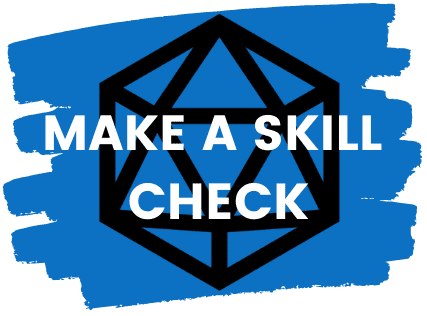More than once, my DM has jokingly said that all his bosses will wear adamantine armor because my rogue shortens their lifespan too much. I have a track record of rolling consecutive critical hits with Sneak Attack—and I roll them in the open! That said, let’s talk about the rules for critical successes and failures and why this particularly helps rogues and paladins.
According to D&D 5e’s basic rules, natural 1s and 20s—before adding modifiers—are the only triggers for critical successes or failures on attack rolls (Player’s Handbook, pg 195) and death saving throws (Dungeon Master’s Guide, pg 197). Critical success/failure for other rolls is an optional rule.
Before we get to the specifics, a heads up: some character features and items modify how critical hits work.
Barbarians have Brutal Critical; champion fighters have Improved Critical; grave clerics can cancel critical hits against allies with their reactions; adamantine armor turns critical hits back into normal hits. . . the list goes on.

Table of Contents
Critical Hits and Misses
When the d20 roll for an attack is 20, the attack hits regardless of the target’s Armor Class (AC), and the damage dice are doubled. This is a critical hit. Note that any modifiers remain unchanged; a +3 does not become a +6.
As an example, your fighter lands a critical hit and rolls 1d8 for damage. For the crit, they now roll 2d8.
However, some tables opt (either by misinterpreting the rules or preference) for rolling the same number of dice, then doubling the result. It’s up to your table to decide which you prefer.
Rolling a 1 means the attack misses regardless of the target’s AC.
This applies to any attack with an attack roll.
In the case of weapon attacks, a critical hit doubles dice from buffs and class features that go alongside the weapon damage, such as Smite, holy weapon, or Sneak Attack. All those sneak attack dice get twice as many, too!
Example: A level 5 Rogue lands a sneak attack with a rapier, doing 1d8 (rapier) & 3d6 (sneak attack); on a crit, this means 2d8 & 6d6!
Exception: Abilities that say ‘immediately after hitting with an attack’ will not gain the bonus from a critical hit.
In addition, the optional rule for lingering injuries (DMG, pg 272) includes critical hits as suitable triggers for injuries.
In my campaigns and one-shots, I have an additional ruling for critical hits: when a PC gets one against an enemy and the target is left with single-digit hit points, I tend to kill the target regardless.
Leaving an opponent alive after a blow like that feels like a “waste of luck,” but getting a critical killing blow feels amazing.
How Do Critical Death Saves Work?
You start rolling death saving throws when you go down with 0 hit points, unconscious and dying.
These are DC 10 Constitution saves. Fail three, you die; beat three, you’re stable, no longer dying, but still unconscious. The successes and failures don’t have to be consecutive.
However, roll a natural 20 (nat 20) on a death save, you rise again, conscious, at 1 hit point.
Roll a natural 1 (nat 1), and you immediately fail two saves. Yikes!
How do Critical Successes and Failures Work with Ability Checks and Saving Throws?
Counting Nat 1s and 20s in these situations is an optional rule (DMG, pg 242), but many assume it’s the standard because it’s intuitive.
The benign way this manifests is DMs wanting to reward awesome rolls with cool moments and make abysmal failures more fun.

On the other end of the spectrum, players think their natural 20s should warp reality to let them do literally whatever, like a wish.
To these players: no, you can’t convince anyone of anything with a natural 20, just like the DM can’t do the same to your characters.
No, Todd, you can’t fly by flapping your arms with a natural 20 on a Strength (Athletics) check.
All this optional ruling does is give DMs permission to “take such an exceptional roll into account when adjudicating the outcome” (DMG, pg 242) of ability checks and saving throws when the roll is a natural 1 or 20.
However, in the current version of One D&D, the next installment in D&D, they are currently trying the “1s always fail; 20s always succeed” for any possible action. This is subject to change.
Examples
Here are some more flavorful ones:
- A natural 1 on a thieves’ tools check to open a door means you fail regardless of the DC and your lockpick breaks, or you make a sound alerting whoever is inside. Perhaps you slip and accidentally ram the door with your shoulder. Bang!
- A natural 20 on the wisdom saving throw to resist an aberration’s mind control lets you push back forcefully, dealing psychic damage or forcing them to beat a Wisdom save or be stunned until the start of their turn.
- A Natural 20 on your Charisma (Performance) check for the evening’s entertainment at the tavern means you get an interesting gift on top of whatever money you get. What might it be?
- A natural 20 on the Dexterity (Acrobatics) check to avoid a shove attempt lets you immediately use your reaction to retaliate with advantage against a wide-open enemy.
- A natural 1 on your Intelligence (History) check means you recall incorrect information. Always fun to make up something completely ridiculous and see how it plays out.
A good caveat: whatever you can do to an enemy in combat, they can probably do to you, too, because:
Monsters and Player Characters Crit Alike
The same critical hit rules apply to the opposition! (DMG pg, 248)
That said, if you use average monster damage instead of rolling it, there’s an extra complication:
[…] if a goblin normally deals 5 (1d6+2) slashing damage on a hit and scores a critical hit, it deals 5+1d6 slashing damage.
DMG, Pg 248
When handling mobs of monsters (aka large groups), the DMG (pg 250) suggests ditching die rolls altogether, eliminating critical hits, in favor of dealing average damage following a table.
Feel free to defy that rule, but I recommend following it because it greatly increases the speed of combat in those circumstances.
Summary
Here’s a handy TL;DR to get you up to speed mid-session if you’re frantically searching between turns:

- Normally, natural (nat) 1s and 20s only apply to attack rolls and death saving throws.
- A nat 20 on an attack roll is a critical hit, and it hits no matter the AC and deals double damage dice (the number of dice; not the result). A 1 always misses—no exceptions.
- Exception: Abilities that say ‘immediately after hitting with an attack’ will not gain the bonus from a critical hit.
- A nat 20 on a death save gets you back up with 1hp, a nat 1 is a double failure.
- Critical success or failure on ability checks and saves is an optional rule, and it boils down to “make it spicy!”
- Critical hit rules apply to monsters, too.
- The exception is that if you use average damage instead of rolling, you should add one damage die roll to the average instead of doubling it on a critical hit.
- Large groups (mobs) of monsters don’t crit if you ditch rolling for them and just deal average damage following the table in the DMG (pg 250.







0 Comments